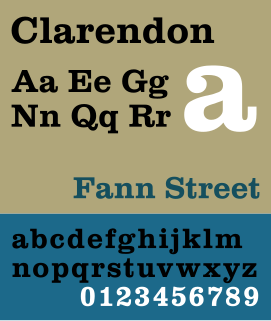Related Research Articles

In typography and lettering, a sans-serif, sans serif, gothic, or simply sans letterform is one that does not have extending features called "serifs" at the end of strokes. Sans-serif typefaces tend to have less stroke width variation than serif typefaces. They are often used to convey simplicity and modernity or minimalism.

In typography, a slab serif typeface is a type of serif typeface characterized by thick, block-like serifs. Serif terminals may be either blunt and angular (Rockwell), or rounded (Courier). Slab serifs were introduced in the early nineteenth century.

Clarendon is the name of a slab-serif typeface that was released in 1845 by Thorowgood and Co. of London, a letter foundry often known as the Fann Street Foundry. The original Clarendon design is credited to Robert Besley, a partner in the foundry, and was originally engraved by punchcutter Benjamin Fox, who may also have contributed to its design. Many copies, adaptations and revivals have been released, becoming almost an entire genre of type design.
Surveyor is a Didone serif typeface that recalls type found on engraved maps and charts. It was designed by Tobias Frere-Jones in 2001 as a custom typeface for use in Martha Stewart Living magazine and released publicly in March 2013, in a wider range of styles, by the type foundry Hoefler & Frere-Jones.

Stephenson Blake is an engineering company based in Sheffield, England. The company was active from the early 19th century as a type founder, remaining until the 1990s as the last active type foundry in Britain, since when it has diversified into specialist engineering.

The London Merchant is playwright George Lillo's most famous work. A tragedy that follows the downfall of a young apprentice due to his association with a prostitute, it is remarkable for its use of middle and working class characters. First performed at the Drury Lane Theatre on 21 June 1731, The London Merchant became one of the most popular plays of the century.

The history of Virginia Beach, Virginia, goes back to the Native Americans who lived in the area for thousands of years before the English colonists landed at Cape Henry in April 1607 and established their first permanent settlement at Jamestown a few weeks later. The Colonial Virginia period extended until 1776 and the American Revolution, and the area has been part of the Commonwealth of Virginia ever since.
Robert Besley (1794–1876) was an English typographer, creator of Clarendon (typeface) in 1845 and the Lord Mayor of London in 1869.
George Mason III was an early American planter, military officer, legislator and local official. Although he repeatedly won election to represent Stafford County in the then-one-house Virginia General Assembly, he may today be best known as the father of George Mason IV, a Founding Father of the United States.
Joseph Fry, was a British type-founder and chocolate maker and founder of the Bristol branch of the Quaker Fry family. He was the first member of his family to settle in Bristol, where he acquired a considerable medical practice, and 'was led to take a part in many new scientific undertakings'.
Edmund Fry (1754–1835) was an English type-founder.

Vincent Figgins was a British typefounder based in London, who cast and sold metal type for printing. After an apprenticeship with typefounder Joseph Jackson, he established his own type foundry in 1792. His company was extremely successful and, with its range of modern serif faces and display typefaces, had a strong influence on the styles of British printing in the nineteenth century.

The Eliot Indian Bible was the first translation of the Christian Bible into an indigenous American language, as well as the first Bible published in British North America. It was prepared by English Puritan missionary John Eliot by translating the Geneva Bible into the Massachusett language. Printed in Cambridge, Massachusetts, the work first appeared in 1661 with only the New Testament. An edition including all 66 books of both the Old and New Testaments was printed in 1663.

Fann Street is a street in the City of London.

The Fann Street Foundry was a type foundry that was located on Fann Street, City of London.
Robert Thorne was a British type founder and typographer. An apprentice to Thomas Cottrell, who had been an employee of William Caslon, Thorne later acquired Cottrell's type foundry. He was successful in business and left a fortune of £25,000 on his death in 1820. Thorne is buried at Holloway Road Cemetery, where his tomb is extant.

Thorowgood Smith was the second mayor of Baltimore from 1804 to 1808. He was appointed to that position when his predecessor James Calhoun resigned. He served for 4 years. He reformed the police system, and ordered the building the plumbing system by the Baltimore water company. Smith was well respected throughout the region. He died in 1810.
Thomas Thorowgood, B.D., was a Puritan minister and preacher in King's Lynn, Norfolk, England. He was the first English author to argue in 1650 that the American Indians were descended from the Lost Ten Tribes of the biblical ancient Israelites, an early 16th century Christian theory that was revived in popularity during the beginning of the English colonisation of North America in the 17th century.

In typography, a fat face letterform is a serif typeface or piece of lettering in the Didone or modern style with an extremely bold design. Fat face typefaces appeared in London around 1805-10 and became widely popular; John Lewis describes the fat face as "the first real display typeface."
Thorowgood is a surname. Notable people with the surname include:
References
- 1 2 Macmillan, Neil (2006). An A-Z of type designers. New Haven: Yale University Press. p. 171. ISBN 9780300111514.